Multi-Parameter Characteristics of Electric Arc Furnace Melting
Abstract
:1. Introduction
2. Materials and Methods
2.1. Theoretical Mathematical Models
2.2. Linear Modelling of Steel Melting in Electric Arc Furnace
- from furnace start-up periods;
- with furnace operation disturbances;
- switching from or to grades with large differences in chemical composition, when there was a justified suspicion of wet pouring;
- with process parameter values that are outliers.
2.3. Mass Balances
2.3.1. Slag Weight Calculations
2.3.2. Calculation of Waste Gas Masses
2.3.3. Calculation of Metal Bath Weight
2.4. Energy Balances
2.4.1. Calculation of the Physical Heat of Hot Metal
2.4.2. Calculation of the Physical Heat of Slag
2.4.3. Calculation of the Physical Heat of Waste Gases
3. Results
4. Discussion
Author Contributions
Funding
Institutional Review Board Statement
Informed Consent Statement
Data Availability Statement
Acknowledgments
Conflicts of Interest
References
- World Steel Association. Steel’s Contribution to a Low Carbon Future and Climate Resilient Societies—World Steel Position Paper; World Steel Association: Brussels, Belgium, 2020; ISBN 978-2-930069-83-8. Available online: https://www.worldsteel.org/en/dam/jcr:7ec64bc1-c51c-439b-84b8-94496686b8c6/Position_paper_climate_2020_vfinal.pdf (accessed on 10 November 2020).
- Carlsson, L.S.; Samuelsson, P.B.; Jönsson, P.G. Using Statistical Modeling to Predict the Electrical Energy Consumption of an Electric Arc Furnace Producing Stainless Steel. Metals 2020, 10, 36. [Google Scholar] [CrossRef] [Green Version]
- Sung, Y.; Lee, S.; Han, K.; Koo, J.; Lee, S.; Jang, D.; Oh, C.; Jang, B. Improvement of Energy Efficiency and Productivity in an Electric Arc Furnace through the Modification of Side-Wall Injector Systems. Processes 2020, 8, 1202. [Google Scholar] [CrossRef]
- Xiaojun, X.; Shufeng, Y.; Jingshe, L.; Jinqiang, W.; Mengjing, Z.; Maolin, Y. Physical model experiment and theoretical analysis of scrap melting process in electric arc furnace combined blowing system. Ironmak. Steelmak. 2020, 47, 748–756. [Google Scholar]
- Gharib Mombeni, A.; Hajidavalloo, E.; Behbahani-Nejad, M. Transient simulation of conjugate heat transfer in the roof cooling panel of an electric arc furnace. Appl. Therm. Eng. 2016, 98, 80–87. [Google Scholar] [CrossRef]
- Coskun, G.; Yiğit, C.; Buyukkaya, E. CFD modelling of a complete electric arc furnace energy sources. Innovations 2016, 4, 22–24. [Google Scholar]
- He, K.; Wang, L.; Li, X. Review of the Energy Consumption and Production Structure of China’s Steel Industry: Current Situation and Future Development. Metals 2020, 10, 302. [Google Scholar] [CrossRef] [Green Version]
- Faraway, J.J. Generalized linear models. In International Encyclopedia of Education, 3rd ed.; Peterson, P., Baker, E., McGaw, B., Eds.; Elsevier: Amsterdam, The Netherlands, 2010; pp. 178–183. [Google Scholar] [CrossRef]
- Cameron, L.T.; Hangos, K.M. Process Modelling and Model Analysis, 1st ed.; Academic Press: San Diego, CA, USA, 2001; Volume 4, pp. 10–17; 253–275. [Google Scholar]
- Haupt, M.; Vadenbo, C.; Zeltner, C.; Hellweg, S. Influence of Input-Scrap Quality on the Environmental Impact of Secondary Steel Production. J. Ind. Ecol. 2017, 21, 391–401. [Google Scholar] [CrossRef]
- Morales, R.D.; Rodriguez, H.; Conejo, A.N. A Mathematical Simulator for the EAF Steelmaking Process Using Direct Reduced Iron. ISIJ Int. 2001, 41, 426–436. [Google Scholar] [CrossRef]
- Bekker, J.G.; Craig, I.K.; Pistorius, P.C. Modeling and Simulation of an Electric Arc Furnace Process. ISIJ Int. 1999, 39, 23–32. [Google Scholar] [CrossRef] [Green Version]
- Logar, V.; Dovžan, D.; Škrjanc, I. Modeling and Validation of an Electric Arc Furnace Part 1, Heat and Mass Transfer. ISIJ Int. 2012, 52, 402–412. [Google Scholar] [CrossRef] [Green Version]
- Logar, V.; Dovžan, D.; Škrjanc, I. Modeling and Validation of an Electric Arc Furnace Part 2, Thermo-chemistry. ISIJ Int. 2021, 52, 413–423. [Google Scholar] [CrossRef] [Green Version]
- Štrumbelj, E.; Kononenko, I. A General Method for Visualizing and Explaining Black-Box Regression Models. In Adaptive and Natural Computing Algorithms; ICANNGA 2011; Lecture Notes in Computer Science; Dobnikar, A., Lotrič, U., Šter, B., Eds.; Springer: Berlin, Germany, 2011; Volume 6594, pp. 21–30. [Google Scholar]
- Banks, H.T.; Tran, H.T. Mathematical and Experimental Modeling of Physical and Biological Processes, 1st ed.; Chapman and Hall/CRC: New York, NY, USA, 2009; pp. 3–5. [Google Scholar]
- Carlsson, L.S.; Samuelsson, P.B.; Jönsson, P.G. Predicting the Electrical Energy Consumption of Electric Arc Furnaces Using Statistical Modeling. Metals 2019, 9, 959. [Google Scholar] [CrossRef] [Green Version]
- Köhle, S. Effects on the electric energy and electrode consumption of arc furnaces. Stahl Eisen 1992, 112, 59–67. [Google Scholar]
- Köhle, S.; Lichterbeck, R.; Paura, G. Verbesserung der Energetischen Betriebsführung von Drehstrom-Lichtbogenöfen; European Commission: Brussels, Belgium, 1996. [Google Scholar]
- Meier, T.; Gandt, K.; Echterhof, T.; Pfeifer, H. Modeling and Simulation of the Off-gas in an Electric Arc Furnace. Metall. Mater. Trans. B 2017, 48, 3329–3344. [Google Scholar] [CrossRef] [Green Version]
- Karbowniczek, M. Electric Arc Furnace Steelmaking, 1st ed.; CRC Press Taylor & Francis Group: Boca Raton, FL, USA, 2021; p. 239. [Google Scholar]
- Köhle, S. Recent improvements in modelling energy consumption of electric arc furnaces. In Proceedings of the 7th European Electric Steelmaking Conference, Venice, Italy, 26–29 May 2002. [Google Scholar]
- Migas, P.; Moskal, M.; Karbowniczek, M.; Czyż, J. Analysis of the energy consumption during the electric arc process. In Proceedings of the Iron and Steelmaking 2019, Modern Metallurgy the XXVIII International Scientific Conference, Liptovský Mikuláš, Slovakia, 23–25 October 2019. [Google Scholar]
- Pretorius, E.; Oltmann, H.; Jones, J. EAF Fundamentals: Charging, Melting and Refining; LWB Refractories: New York, NY, USA, 2005; pp. 16–21. [Google Scholar]
- Bergman, K.; Gottardi, R. Design criteria for the modern UHP electric arc furnace with auxiliaries. Ironmak. Steelmak. 1990, 17, 282–287. [Google Scholar]
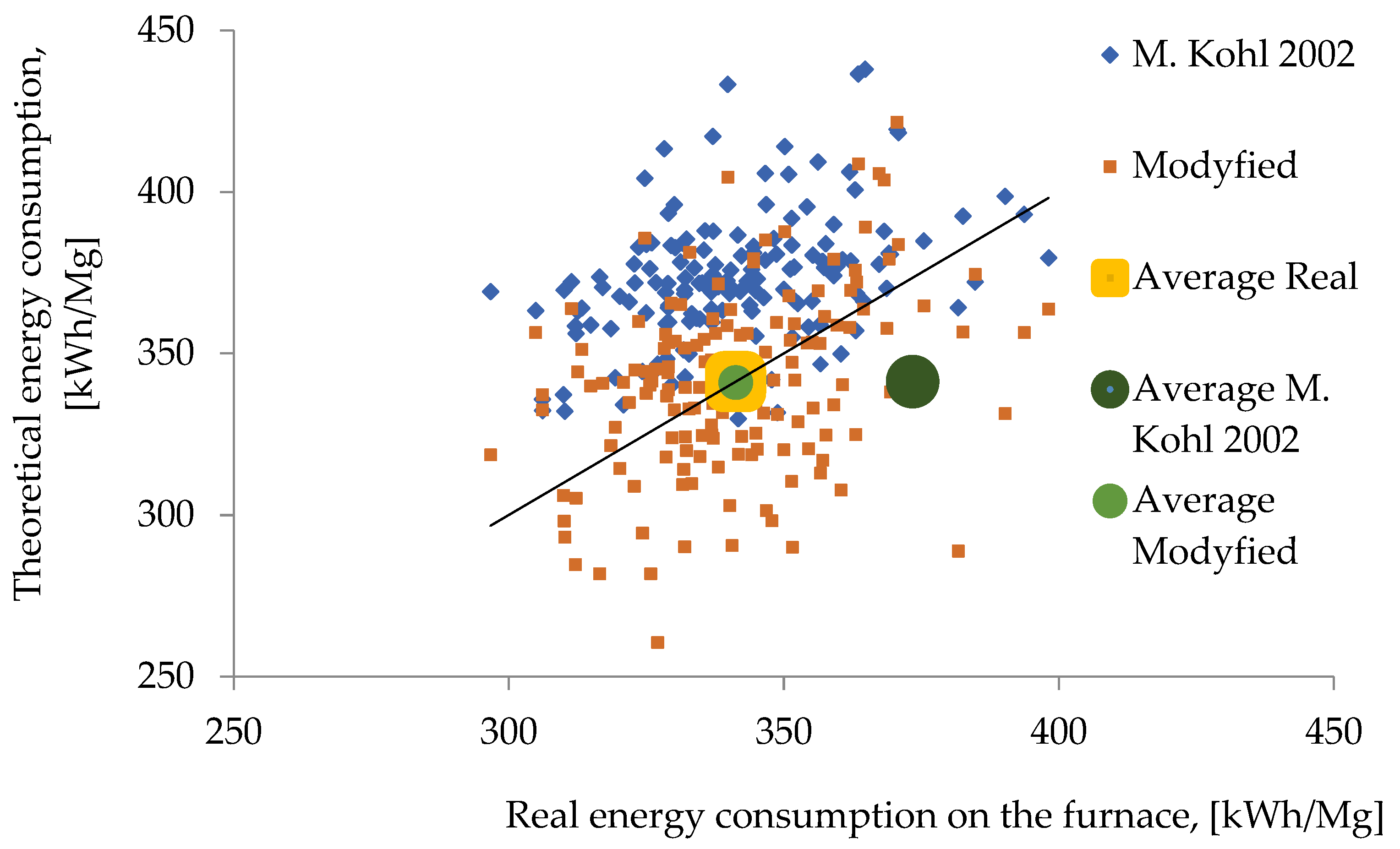
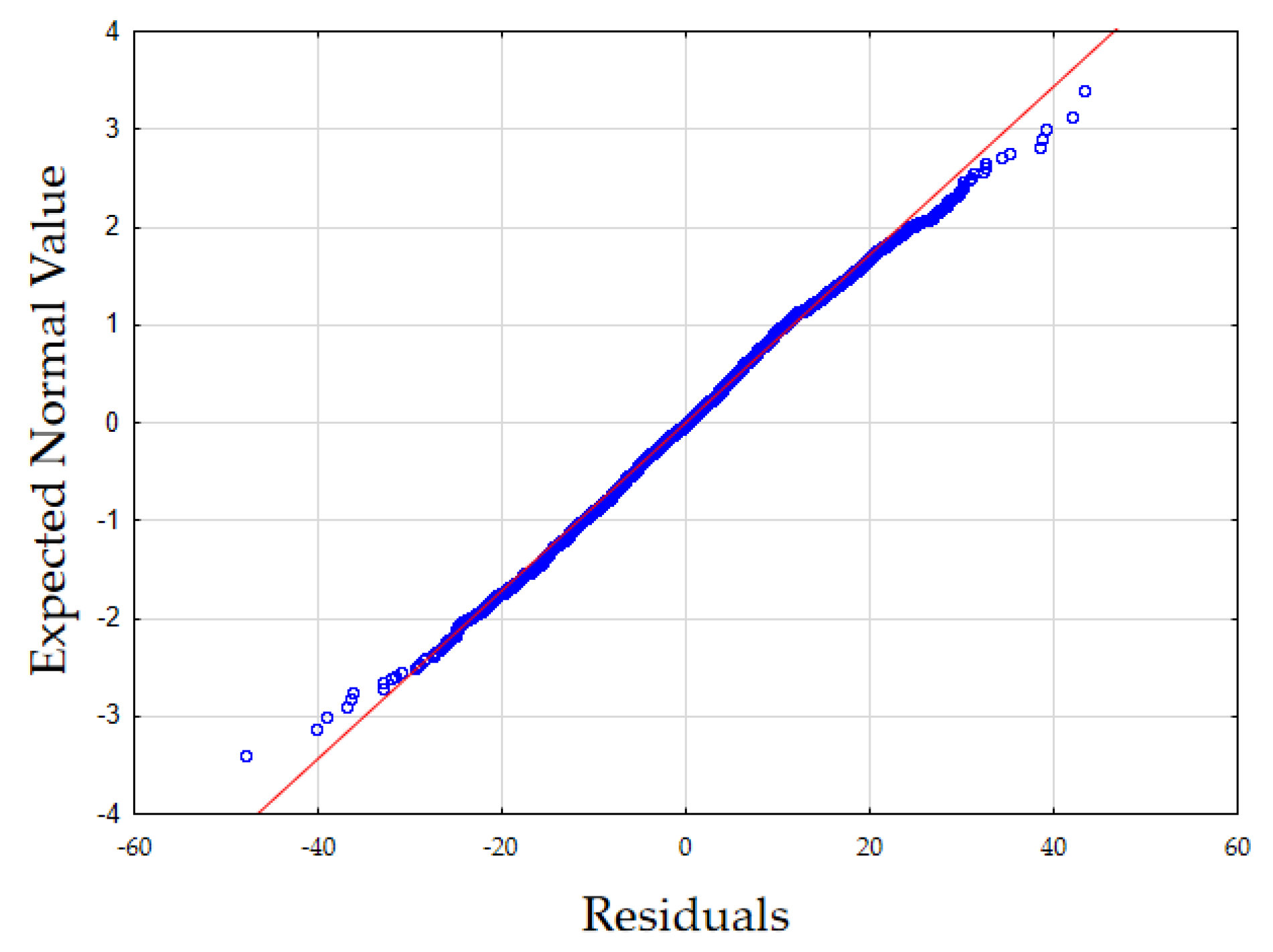
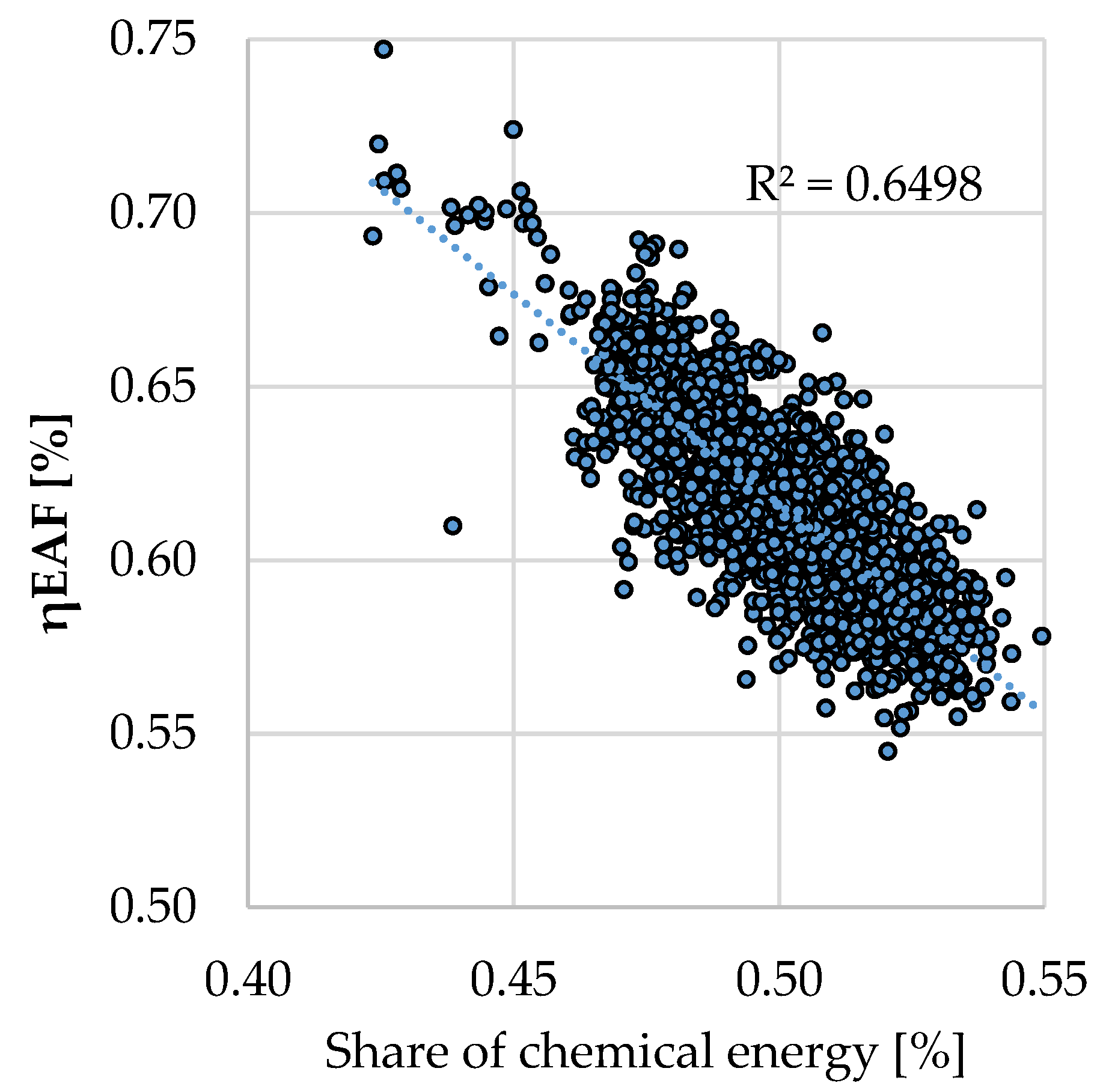
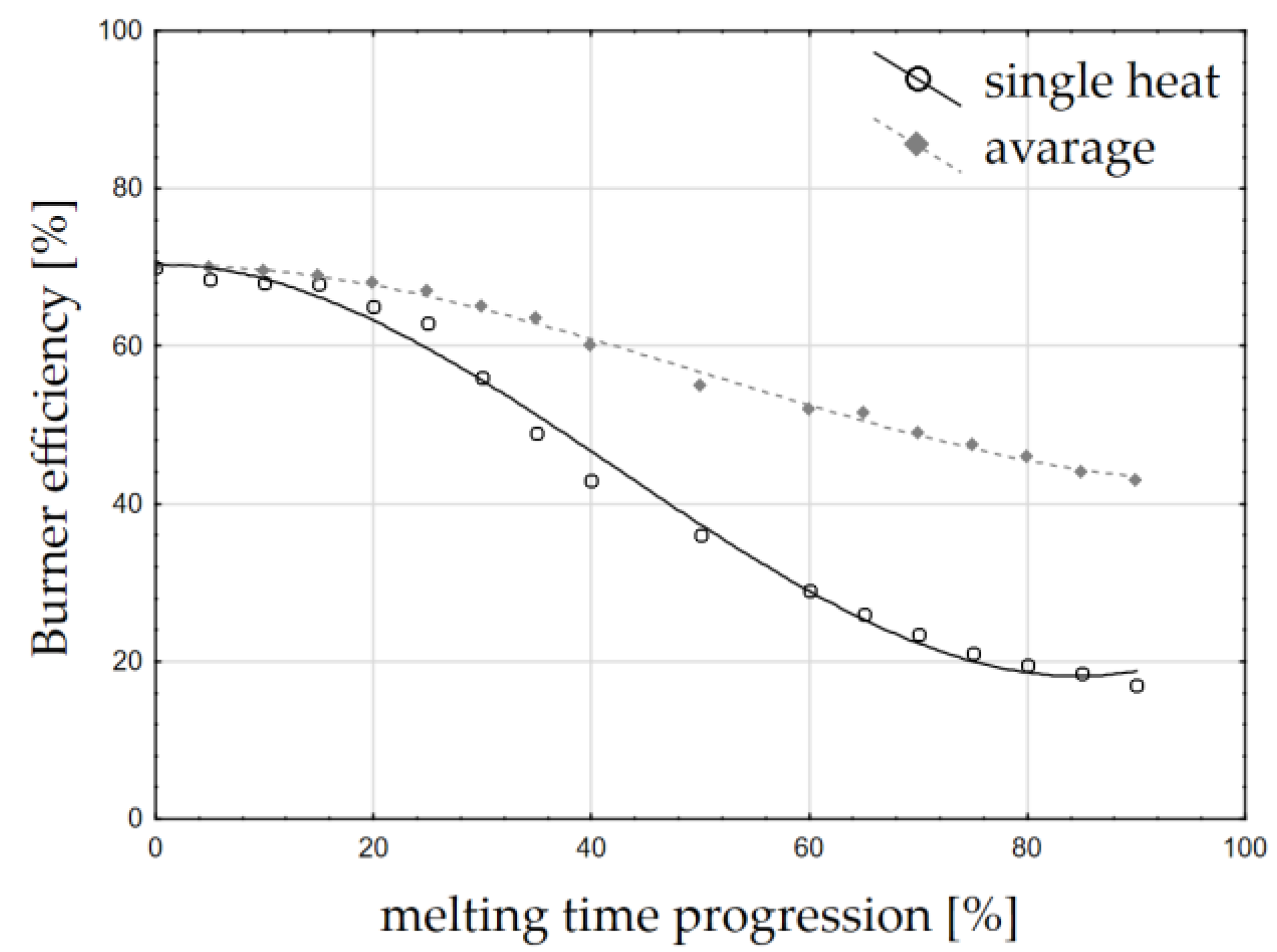
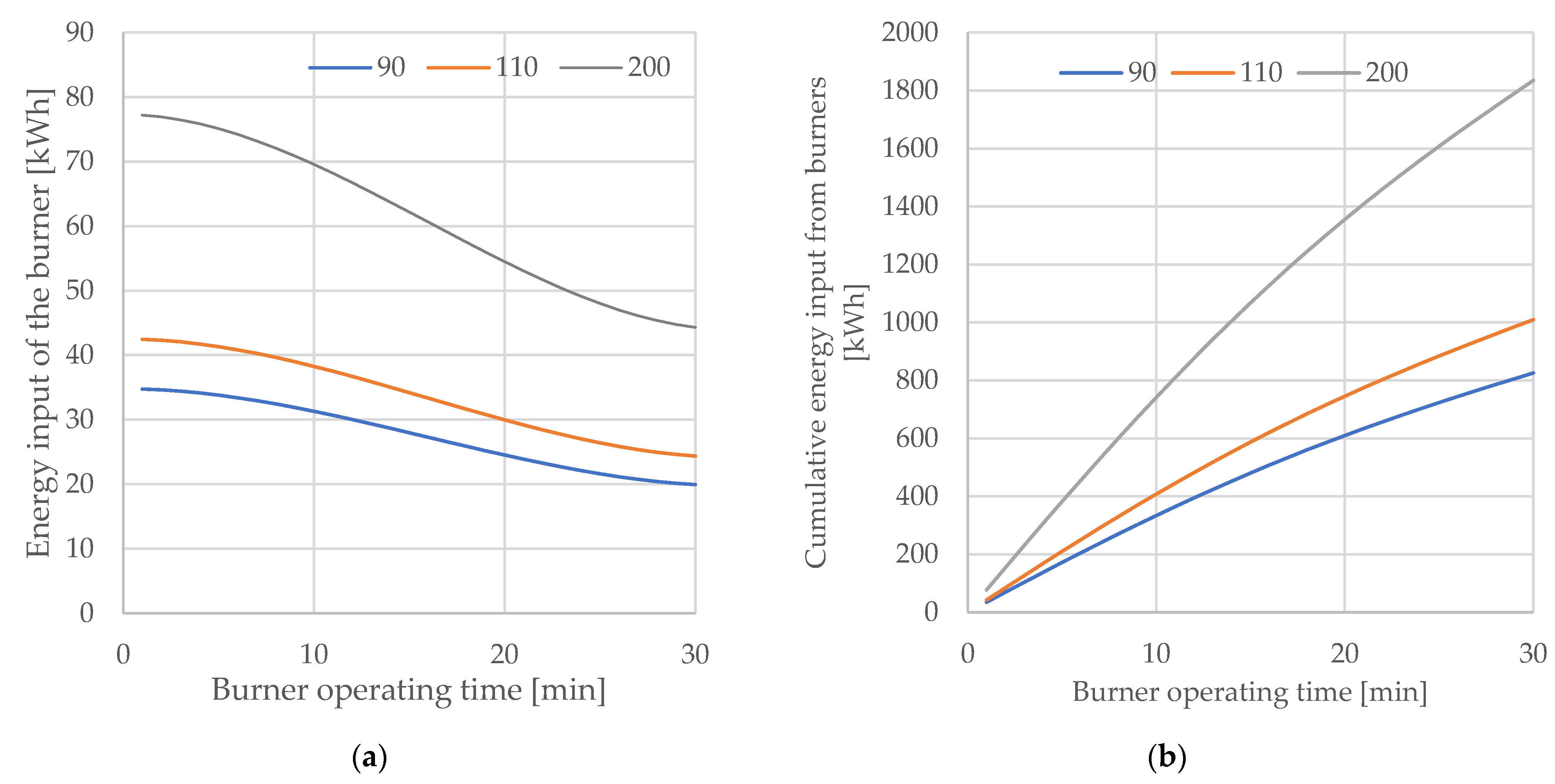
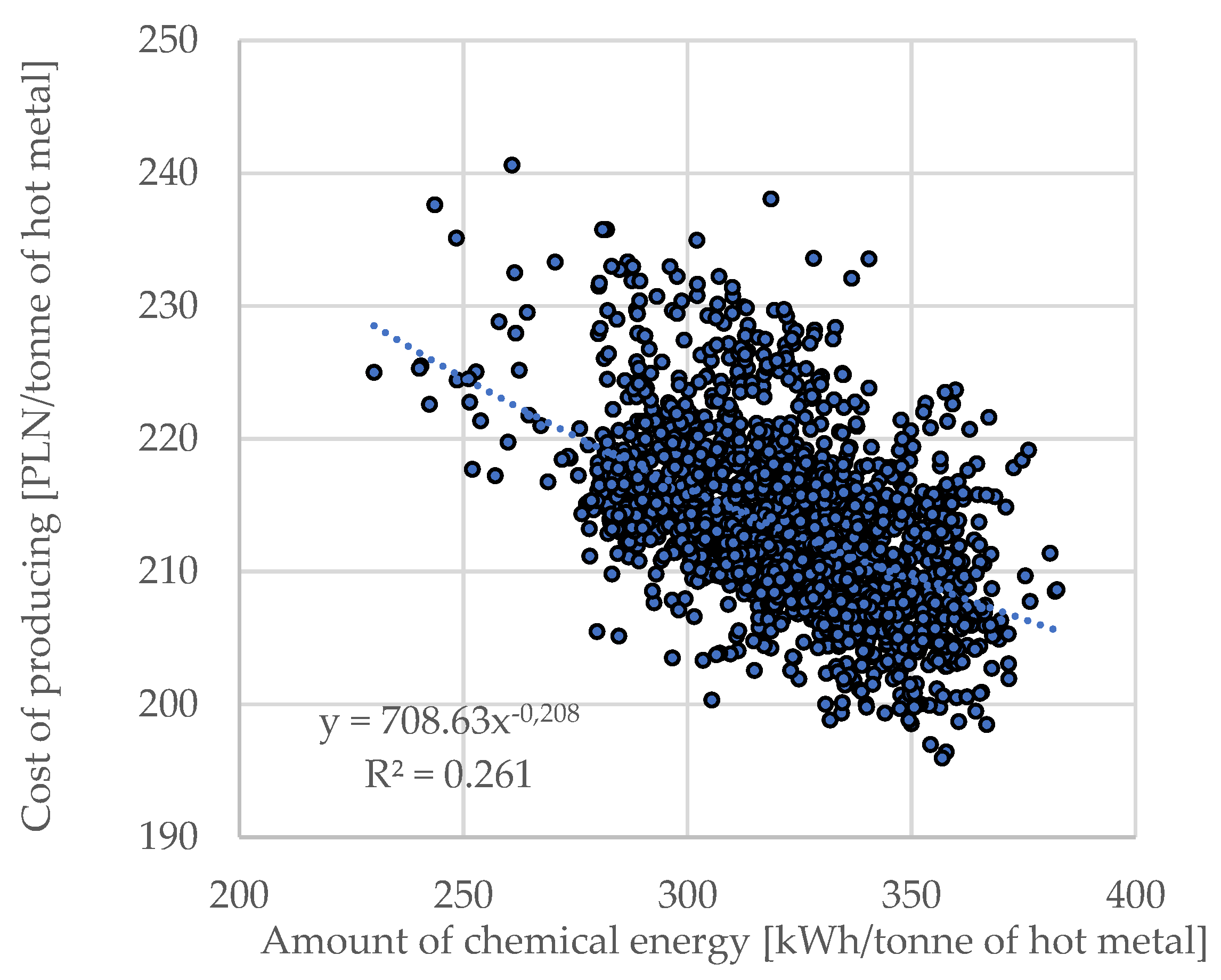
| Element | C | Mg | Si | P | S | Cu | Ni | V | Mo | Cr |
|---|---|---|---|---|---|---|---|---|---|---|
| ki | 65 | 5 | 8 | 30 | 25 | 5 | 4 | 2 | 2 | 1.5 |
| Oxide | CaO | MgO | MnO | Cr2O3 | SiO2 | P2O5 | Al2O3 | TiO2 | FeO |
|---|---|---|---|---|---|---|---|---|---|
| % of weight | 29.54 | 5.71 | 9.09 | 7.52 | 9.55 | 0.41 | 1.19 | 0.42 | 36.57 |
| Element | C | Mn | Cr | Ni | Si | P | S |
|---|---|---|---|---|---|---|---|
| % of mass | 0.071 | 0.083 | 0.107 | 0.109 | 0.005 | 0.008 | 0.107 |
| Variable | b* | Std. Err. of b* | B | Std. Err. of b | t(1953) | p-Value |
|---|---|---|---|---|---|---|
| Intercept | 169.942 | 8.689 | 19.558 | 0.000 | ||
| Tap-to-tap time | 0.248 | 0.020 | 0.263 | 0.021 | 12.324 | 0.000 |
| Oxygen to charge | 0.403 | 0.020 | 3271 | 0.166 | 19.670 | 0.000 |
| Natural gas to charge | −0.055 | 0.020 | −2633 | 0.952 | −2767 | 0.006 |
| Slag formers to charge | 0.064 | 0.020 | 0.113 | 0.036 | 3166 | 0.002 |
| Scrap yield | 0.123 | 0.021 | 48.787 | 8.377 | 5.82 | 0.000 |
Publisher’s Note: MDPI stays neutral with regard to jurisdictional claims in published maps and institutional affiliations. |
© 2022 by the authors. Licensee MDPI, Basel, Switzerland. This article is an open access article distributed under the terms and conditions of the Creative Commons Attribution (CC BY) license (https://creativecommons.org/licenses/by/4.0/).
Share and Cite
Moskal, M.; Migas, P.; Karbowniczek, M. Multi-Parameter Characteristics of Electric Arc Furnace Melting. Materials 2022, 15, 1601. https://doi.org/10.3390/ma15041601
Moskal M, Migas P, Karbowniczek M. Multi-Parameter Characteristics of Electric Arc Furnace Melting. Materials. 2022; 15(4):1601. https://doi.org/10.3390/ma15041601
Chicago/Turabian StyleMoskal, Michał, Piotr Migas, and Mirosław Karbowniczek. 2022. "Multi-Parameter Characteristics of Electric Arc Furnace Melting" Materials 15, no. 4: 1601. https://doi.org/10.3390/ma15041601
APA StyleMoskal, M., Migas, P., & Karbowniczek, M. (2022). Multi-Parameter Characteristics of Electric Arc Furnace Melting. Materials, 15(4), 1601. https://doi.org/10.3390/ma15041601






